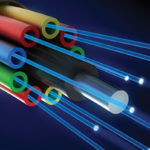Smart Building Networks have many requirements like flexibility, the ability to scale up or down, Power of Ethernet (POE), Cloud applications and support of Internet of Things. The networks in smart buildings need to support a wide range of applications and devices, from communications and telephony to facility management systems, security and access control, wireless access points and IoT devices.
Traditionally, cabling in buildings was equipped with a vertical backbone. It rises through the building and branches off wherever a floor converges and then it would run to individual devices. However, If there comes a change in the designated use of space in the building, recabling involves a lot of work like tearing down the walls or adding the ports. So, a new approach was introduced,using pathways and consolidation points on different floors. This approach offers freedom in developing solutions but the designers need to adhere to fixed routes. This has made designing, configuring and reconfiguring networks more easier and suitable for smart buildings.
Fibre or copper? Which is best for Smart buildings?
Fibre is the best solution wherever the highest speeds and lowest latency are required but not every connection in a building needs the highest possible speed. Over 100m distances, Cat.6A cabling supports speed up to 10GB/s which is sufficient for most in-building applications. Apart from speed and latency, there are other criterias to be considered. One reason why fibre is utilised is because of the fact that it can carry data over considerable lengths whereas copper’s physical resistance means its use is limited to shorter lengths.
A Fibre based LAN goes with a number of costly elements like UPS power, floor space, data grounds and cabling closets. Fibre uses fewer electrical components, eliminating potential difficulties related to interference. It doesn’t mean that fibre isn’t affected by other kinds of interference. If light sources are not monochromatic, pulse interference may occur. Copper isn’t excessively troubled by interference.
It is very important to take great care when installing copper as well as fibre but copper tends to be more cost effective when it comes to maintenance and rerouting. Copper supports good devices but an All-Fibre Lan would require hardware and equipment upgrades that may boost fibre adoption costs.
Therefore, both fibre and copper have their pros and cons depending upon the specific requirements. Fibre and copper solutions will always exist side by side. Each is used in applications where they add good value with a price point that makes sense for the business. Opting for ‘just adequate’ cabling can affect performance, but installing the highest performing cable every inch of the network is costly and pointless. It is always good to consider the cost and efforts related to maintenance, installation configuration and reconfiguration. Taking time to select the perfect type and quality for different parts of the network pays-off in the long run.

